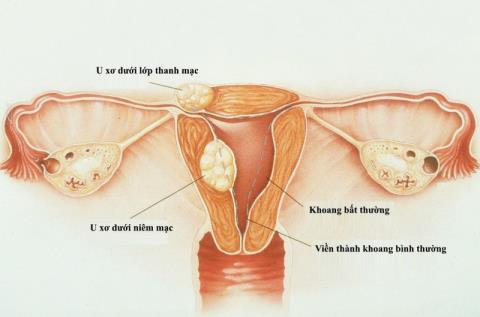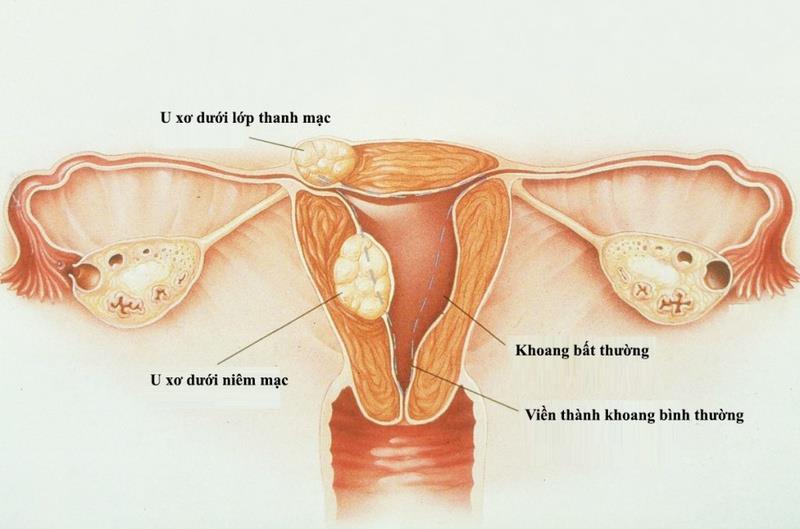Is cervical nabothian cyst a dangerous disease? Causes and treatments

Cervical nabothian cyst is a common gynecological condition in women. Cysts have a small tumor shape, appearing on the surface of the cervix. Let's find out what causes nabothian cysts and some effective treatments!
Small cervical nabothian cysts will be eliminated by a natural mechanism if the patient has good resistance. For cases of nabothian cysts that are difficult to handle, usually large cysts or symptoms of severe disease, the doctor may give the patient medication, aspiration or perform nabothian cyst burning to treat. radical disease.
What is a nabothian cyst?
Nabothian cysts (also known as epithelial tumors) are small lumps that form on the surface, inside the cervical canal. Small nabothian cysts are only a few millimeters in diameter, and abnormally large cysts can reach 4 cm or even more.
Cervical nabothian cyst is more common in women who have given birth or are in menopause. As women get older, the thickness of their cervical lining also gradually decreases, creating favorable conditions for some gynecological diseases to develop.
Most nabothian cysts are benign and do not cause serious complications. This makes many patients subjective, easily skipping the definitive treatment phase when the disease is still mild. Therefore, people with cervical nabothian cysts should be careful with their health status, should go to a medical facility to check and treat the disease early to limit the potential risks.
Close-up of cervical nabothian cyst
Signs of nabothian cysts
Most of the symptoms of cervical nabothian cysts are similar to those of common gynecological diseases. Therefore, it will be difficult for women to know exactly if they have nabothian cysts or not. Women should schedule regular gynecological exams to get the most accurate diagnosis. Here are some signs that you can refer to to detect nabothian cysts early:
- Vaginal discharge more than usual, milky white, yellow, especially with a very unpleasant fishy odor.
- Menstrual disorders , abnormal vaginal bleeding even though the period has not yet come.
- Persistent menstrual pain during menstruation.
- Lower abdominal pain occurs frequently, affecting daily life.
- During sex, I feel pain, sometimes bleeding.
- Vagina feels full, uncomfortable, lack of sex drive.
Patients often have persistent abdominal pain throughout the menstrual cycle
What causes cervical nabothian cyst?
Nabothian cysts are formed when the layer of squamous epithelial cells of the cervix proliferates, covering the sebaceous glands in the cervical lining, causing severe obstruction. Over time, cysts are formed on the cervix.
The pathogenesis of nabothian tumors also originates from many other factors. Let's take a look at the factors that contribute to the formation of nabothian cysts:
- Reduced cellular energy: Reduced cellular energy will disconnect the ability to communicate between cells. Cells no longer divide in a good way. This long-term condition leads to the fact that abnormal, long-term proliferation creates cystic masses, especially nabothian cysts in the cervix.
- Cervical ectropion : The epithelium in the cervix of the patient is exposed to the outside, very easily blocked. At the same time, cervical mucus continues to be secreted but cannot be expelled, accumulates for a long time and forms nabothian cysts.
- Cervical ulcer: Inflammation of the cervix is also one of the main causes of tissue cell proliferation, covering the sebaceous glands. Fluid stagnation occurs, gradually aging to form one or more cervical nabothian cysts.
- Due to other gynecological diseases: Some other common gynecological diseases such as cervical infection, vaginitis , cervical fibroids ... also have the risk of stagnation of vaginal fluid at the cervix. In case women with gynecological diseases are not properly treated, the cervix is very likely to have nabothian cysts.
 Cervical fibroids are very susceptible to nabothian cysts
Cervical fibroids are very susceptible to nabothian cysts
Are nabothian cysts in the cervix dangerous?
Pure nabothian cyst is just a benign lesion on the cervix. Therefore, most nabothian cysts are not too big of a concern for women. However, nabothian cysts will become a real headache when the cysts grow abnormally and large in size. In particular, when the cystic mass grows to the maximum and then bursts on its own, causing inflammation of the cervix and affecting the conception process.
Small nabothian cysts will resolve spontaneously without medical intervention. However, if the cyst is large enough to rupture on its own, the fluid inside the cyst is released, causing the cervix to become inflamed and infected. The serious condition can even affect the reproductive health of people with nabothian cysts of the cervix. Here are the basic methods to effectively treat nabothian cysts:
Use medicine
The patient will be prescribed medication to treat nabothian cysts when the number of cysts is small and the size of the cysts is small, the condition is not too serious. Under the effect of the drug, the nabothian cyst will be eliminated, and the cervix will be stable again.
Patient taking medication to treat naboth cyst
Patients should absolutely follow the doctor's prescription, do not arbitrarily use drugs not recommended by the doctor or use drugs of unknown origin. This not only makes the patient lose money, but also makes the disease worse. Naboth cysts, when untreated, will become severe, with extremely unpredictable consequences.
Aspiration aspiration
Cervical nabothian cysts need aspiration intervention when the cysts grow too large and stick together in clusters. This method optimizes puncture to drain fluid and cause the cyst to collapse.
This procedure takes less time to perform, can minimize the possibility of extensive damage. However, aspiration to treat nabothian cysts does not help circulation of blood and mucus in the cervix. Therefore, patients easily fall into the case of nabothian cysts that recur quickly and many times later.
Burn nabothian cyst
Nabothian cyst ablation is a common procedure in many cases of nabothian cysts. The two leading methods of cauterization of nabothian cysts are electrocautery and cryoablation.
- Electrocautery: The patient is under local anesthesia, the doctor uses an electric current to burn the outer layer of the cervix, whereby the nabothian cysts on the surface of the cervix will be burned. This method needs to be careful in the post-gynecological care to minimize the risk of wound infection when electrocautery.
- Cryotherapy: Cryotherapy, also known as cryotherapy, is the use of liquid nitrogen gas to freeze nabothian cyst cells, then perform tumor destruction without the need for many invasive procedures such as electrocautery. Cryosurgery to deal with cervical nabothian cysts is quite expensive but brings high therapeutic effect.
Above is all the information related to cervical nabothian cyst pathology , hope that the article has provided you with a lot of useful knowledge. If you are wondering whether you have this nabothian cyst, quickly make an appointment and visit the hospital as soon as possible to understand the situation clearly!